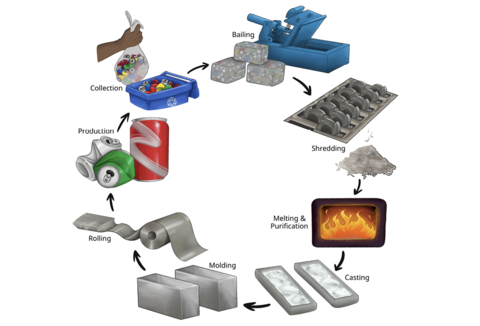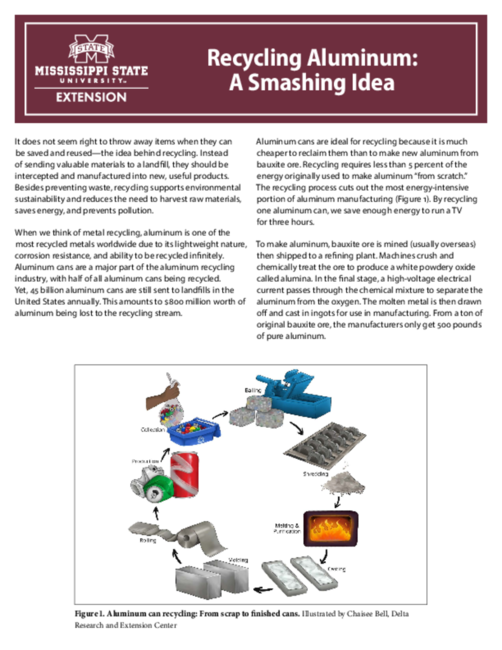P1672
Recycling Aluminum: A Smashing Idea
It does not seem right to throw away items when they can be saved and reused—the idea behind recycling. Instead of sending valuable materials to a landfill, they should be intercepted and manufactured into new, useful products. Besides preventing waste, recycling supports environmental sustainability and reduces the need to harvest raw materials, saves energy, and prevents pollution.
When we think of metal recycling, aluminum is one of the most recycled metals worldwide due to its lightweight nature, corrosion resistance, and ability to be recycled infinitely. Aluminum cans are a major part of the aluminum recycling industry, with half of all aluminum cans being recycled. Yet, 45 billion aluminum cans are still sent to landfills in the United States annually. This amounts to $800 million worth of aluminum being lost to the recycling stream.
Aluminum cans are ideal for recycling because it is much cheaper to reclaim them than to make new aluminum from bauxite ore. Recycling requires less than 5 percent of the energy originally used to make aluminum “from scratch.” The recycling process cuts out the most energy-intensive portion of aluminum manufacturing (Figure 1). By recycling one aluminum can, we save enough energy to run a TV for three hours.

To make aluminum, bauxite ore is mined (usually overseas) then shipped to a refining plant. Machines crush and chemically treat the ore to produce a white powdery oxide called alumina. In the final stage, a high-voltage electrical current passes through the chemical mixture to separate the aluminum from the oxygen. The molten metal is then drawn off and cast in ingots for use in manufacturing. From a ton of original bauxite ore, the manufacturers only get 500 pounds of pure aluminum.
Launching A Recycling Program
If you would like to start your own recycling campaign, consider these techniques:
- Identify aluminum recycling centers. Search the internet to find aluminum recyclers in your area. The iScrap App is a great resource to use. Determine rates, hours of operation, and procedures for cashing in your cans at each center.
- Sell members of your group on the idea. Start with a meeting to introduce the program. Ask for volunteers to plan strategies and produce materials, keep records, and deliver cans to recycling centers. Keep interest high with a contest among members. Challenge them to collect a determined number of cans or raise a set amount of money.
- Recruit the aid of local businesses that sell beverages in aluminum cans. Many service stations, restaurants, and stores would welcome the opportunity to help a worthy cause. They can make your group’s job easier by keeping aluminum cans in separate containers until you are able to pick them up. You may need to leave a special container at each site.
- Reach out to others by posting on social media about your collection campaign on local community group pages. Advertise how you will use the proceeds and where drop-out bins are located. Where permitted, display flyers in public areas.
- Recycle wisely. Wait until you have a large quantity of cans to return so you don’t waste time and gas. Load the cans in large plastic bags or boxes. Make sure that the cans you collect are made of aluminum. Most aluminum cans are clearly marked. When in doubt, check with a magnet. Aluminum cans are not magnetic. You don’t have to smash your aluminum cans before delivering them to the recycling center, but it does save space in your containers.
References
The Aluminum Association. (2021). Every can counts: An aluminum beverage can recycling manifesto (PDF).
Environmental Protection Agency. (2025). Aluminum: Material-specific data.
Publication 1672 (POD-10-25)
Revised by Sherry Bell, PhD, Associate Extension Professor, Central Mississippi Research and Extension Center, from the original by Carol Short, former Assistant Professor.
The Mississippi State University Extension Service is working to ensure all web content is accessible to all users. If you need assistance accessing any of our content, please email the webteam or call 662-325-2262.
